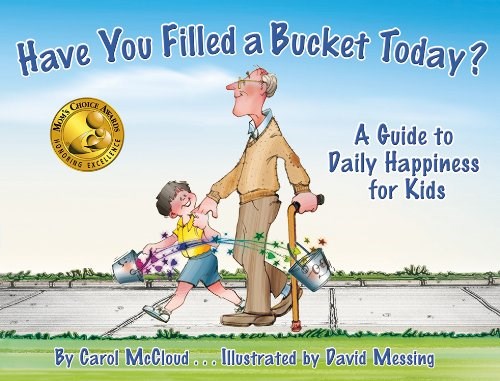Kindness & BucketFilling
What is this Bucket Filling all about?
Are you wondering why there are buckets hanging in the halls and pods at Valley View? These buckets are visual reminders for students regarding the concept of “bucket filling”. We are using the idea of “bucket filling” to reinforce positive and kind behaviours, words, and actions, and to give children a representation or context to what that looks like and why it is important. As a school, we address and reinforce the importance of how we treat each other, kindness, and gratitude in various ways- visual representations, conversations, curriculum, modelling and TIGER, etc. These themes and ideas also directly relate to the new BC Curriculum with the Personal and Social Responsibility Competencies. Below you will find some more detailed information about “bucket filling”. As always, if you have any questions, please come chat with us!
Where did the idea of “Bucket Filling” start?
The idea of a reservoir that is “full” or “filled” refers to positive attributes, such as being filled with joy, wisdom, love, faith etc. In the 1960s, Dr. Donald O. Clifton (1924-2003) first created the “Dipper and Bucket” story, which depicted the reservoir as an invisible bucket. In 2002 the American Psychological Association presented Clifton with its Presidential Commendation for lifetime contributions as “the father of strengths-based psychology and the grandfather of positive psychology.” Dr. Clifton’s 50 years of research initiated a movement that has increased positive moments and reduced negative moments in countless lives. His legacy of wisdom and inspiration continues today.
Who helped to spread the concept of Bucket Filling?
In the 1970s, John E. Valusek, Ph.D., a respected psychologist and advocate for the prevention of child abuse, wrote about bucket filling and bucket dipping in his Bits and Pieces Jottings and Some Ways of Thinking About Human Behavior. He explained that, “How we feel and how we will behave at any given moment is dependent upon how much or how little we have in our buckets.”
Carol McCloud was an early childhood educator in the 1990s when she learned of the bucketfilling concept while attending an early childhood conference. As she followed the new research on mental, emotional, and social development that was being uncovered in the orphanages of Romania, she began to understand more clearly the intense need that all children share to have their buckets filled by caring adults.
In 2005, while talking to a teacher, she began to wonder why no one had yet taught this amazing concept to young children and was inspired to write her first book, Have You Filled a Bucket Today? A Guide to Daily Happiness for Kids. Within a month of publication, teachers from schools around the country were calling her to help them create “bucketfilling schools”. Since then, thousands of schools around the world have used the bucketfilling ideas and concepts to become “bucketfilling schools” where kindness and respect are taught, practiced, and valued by all.
What is the “bucket”?
The bucket represents your mental and emotional self.
How do you feel when your bucket is full?
When your bucket is full, you feel more confident, secure, calm, patient, and friendly. Your thoughts are positive and you expect positive results. When your bucket is overflowing, you experience an intense happiness that can spread to those around you. Have you ever felt better after someone gave you a friendly smile or happy grin? This is the “ripple effect” of a full bucket.
How do you feel when your bucket is empty?
When your bucket is empty, it contains few, if any, positive thoughts or feelings. When your bucket is empty you can easily become sad, negative, insecure, nervous, angry, depressed, stressed, worried, afraid, or physically ill. When you experience any of these feelings, it’s easy to believe that life is too challenging and that nothing you attempt will be successful. An empty bucket can affect your behavior and cause you to express your emotions in a way that empties the buckets of those around you.
What affects the level of happiness in your bucket?
Negative life events. The careless or even cruel words and behavior of others can also affect the level of happiness in your bucket. Your own self-talk and thoughts can dramatically reduce or raise the level of happiness in your bucket. It’s important to know that you are responsible for what you choose to think and when your thoughts are positive and healthy, your bucket levels will reflect it.
What is Bucket Filling?
Actions or words that show that you care about someone. Saying or doing something kind. Giving someone a heartfelt smile. Using names with respect. Helping without being asked. Giving sincere compliments. Showing respect to others. There are hundreds of wonderful ways to fill buckets. The language of bucket filling has become synonymous with being kind and thoughtful. Your bucket will be filled when, at the close of each day, you reflect on the ways in which you have filled buckets.
What is Bucket Dipping?
Making fun of someone. Saying or doing unkind things. Refusing to help. Failing to show respect or being intentionally disrespectful. This is a partial list of ways in which it’s possible to dip into another’s bucket. Another is bullying, the behavior that has become the essence of bucket dipping. It is very important that we learn to understand the motivation for these behaviors.
Note: It is also dipping when we unintentionally dip into another’s bucket with a thoughtless word or careless action. These are small and should be repaired with a swift, sincere apology.


